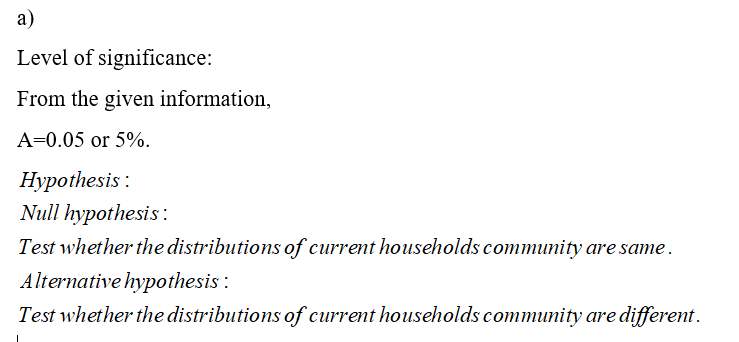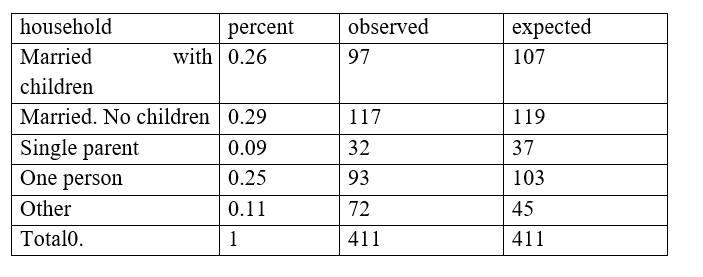The type of household for the U.S. population and for a random sample of 411 households from a community in Montana are shown below. Observed Number Percent of U.S. Type of Household of Households in the Community Households 26% 29% Married with children Married, no children Single parent One person Other (e.g., roommates, siblings) 97 117 9% 32 25% 93 11% 72 Use a 5% level of significance to test the claim that the distribution of U.S. households fits the Dove Creek distribution.
The type of household for the U.S. population and for a random sample of 411 households from a community in Montana are shown below. Observed Number Percent of U.S. Type of Household of Households in the Community Households 26% 29% Married with children Married, no children Single parent One person Other (e.g., roommates, siblings) 97 117 9% 32 25% 93 11% 72 Use a 5% level of significance to test the claim that the distribution of U.S. households fits the Dove Creek distribution.
MATLAB: An Introduction with Applications
6th Edition
ISBN:9781119256830
Author:Amos Gilat
Publisher:Amos Gilat
Chapter1: Starting With Matlab
Section: Chapter Questions
Problem 1P
Related questions
Question
(a) What is the level of significance?
(b) Find the value of the chi-square statistic for the sample. (Round the expected frequencies to at least three decimal places. Round the test statistic to three decimal places.)
What are the degrees of freedom?

Transcribed Image Text:The type of household for the U.S. population and for a random sample of 411 households from a community in Montana are shown below.
Observed Number
Percent of U.S.
Type of Household
of Households in
the Community
Households
26%
29%
Married with children
Married, no children
Single parent
One person
Other (e.g., roommates, siblings)
97
117
9%
32
25%
93
11%
72
Use a 5% level of significance to test the claim that the distribution of U.S. households fits the Dove Creek distribution.
Expert Solution
Step 1

Step 2
b)
From the given data,
Expected frequency = n*Pi
Where, n is the sample size
Step 3

Step 4
From the above table,
The degrees of freedom = n-1
=5-1
=4
Step by step
Solved in 8 steps with 5 images

Knowledge Booster
Learn more about
Need a deep-dive on the concept behind this application? Look no further. Learn more about this topic, statistics and related others by exploring similar questions and additional content below.Recommended textbooks for you

MATLAB: An Introduction with Applications
Statistics
ISBN:
9781119256830
Author:
Amos Gilat
Publisher:
John Wiley & Sons Inc

Probability and Statistics for Engineering and th…
Statistics
ISBN:
9781305251809
Author:
Jay L. Devore
Publisher:
Cengage Learning

Statistics for The Behavioral Sciences (MindTap C…
Statistics
ISBN:
9781305504912
Author:
Frederick J Gravetter, Larry B. Wallnau
Publisher:
Cengage Learning

MATLAB: An Introduction with Applications
Statistics
ISBN:
9781119256830
Author:
Amos Gilat
Publisher:
John Wiley & Sons Inc

Probability and Statistics for Engineering and th…
Statistics
ISBN:
9781305251809
Author:
Jay L. Devore
Publisher:
Cengage Learning

Statistics for The Behavioral Sciences (MindTap C…
Statistics
ISBN:
9781305504912
Author:
Frederick J Gravetter, Larry B. Wallnau
Publisher:
Cengage Learning

Elementary Statistics: Picturing the World (7th E…
Statistics
ISBN:
9780134683416
Author:
Ron Larson, Betsy Farber
Publisher:
PEARSON

The Basic Practice of Statistics
Statistics
ISBN:
9781319042578
Author:
David S. Moore, William I. Notz, Michael A. Fligner
Publisher:
W. H. Freeman

Introduction to the Practice of Statistics
Statistics
ISBN:
9781319013387
Author:
David S. Moore, George P. McCabe, Bruce A. Craig
Publisher:
W. H. Freeman